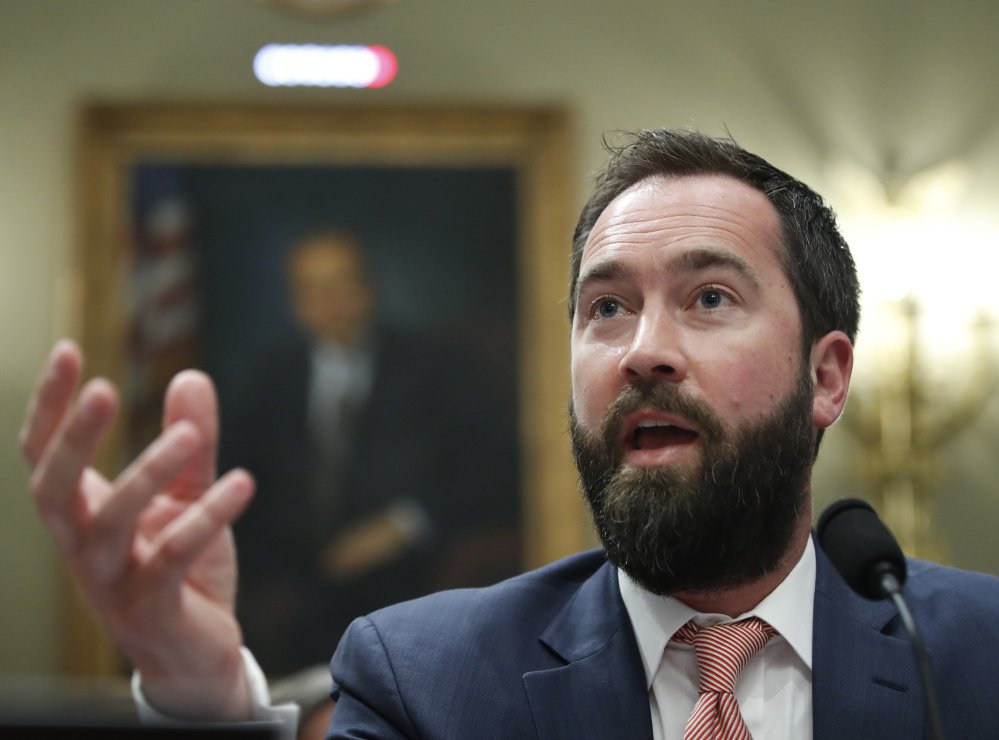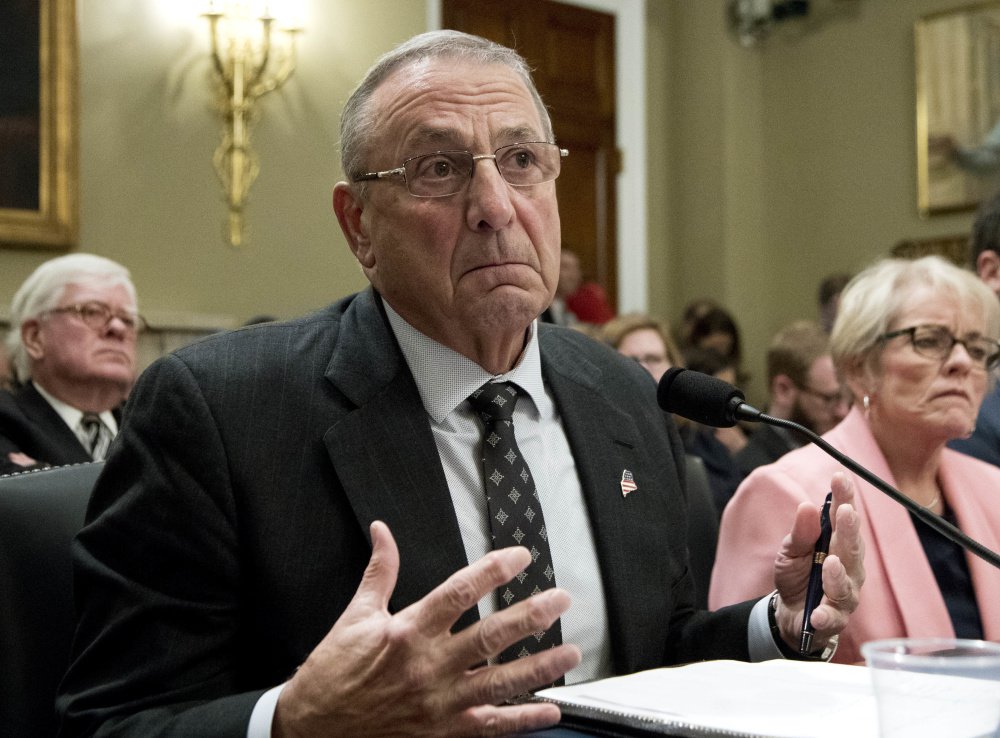Maine’s Katahdin Woods and Waters National Monument took center stage in the political debate over national monuments Tuesday in Washington, where Gov. Paul LePage and the monument’s chief advocate offered dueling testimony on its creation and economic potential.
Testifying before a congressional subcommittee, LePage referred to the 87,500-acre monument as “cutover” forest lands unlikely to economically benefit the region “in my lifetime.” He suggested “uninspired” monument visitors could overwhelm neighboring Baxter State Park, and accused the National Park Service and former President Barack Obama of ignoring local opposition – including three nonbinding municipal votes – when designating the monument last August.
“Instead, they sided with special-interest groups over the views of Maine people and a state law,” LePage, a longtime opponent of the monument, told members of the Federal Lands Subcommittee of the House Natural Resources Committee. “The only major selling point to attracting visitors to this newly established national monument is the view of Mount Katahdin. This is somewhat ironic because Mount Katahdin is already under conservation in Maine’s premier Baxter State Park, which I would argue is one of the greatest wilderness parks east of the Rocky Mountains.”
But Lucas St. Clair told the subcommittee that his family engaged in extensive public outreach, holding meetings throughout the Katahdin region over several years and adjusting the plan before donating the land to the park service. St. Clair also noted that some Katahdin-area businesses already are seeing positive impacts.
“Businesses are starting to grow and expand,” St. Clair said. “Jobs are being created. Real estate prices have started to rebound. And there are new, significant private-sector investments, including plans for a $5 million outdoor recreational school. … Even longtime opponents have started to come around as they have begun to recognize the benefits of having a national monument near their communities.”
PARTISAN DISAGREEMENT ON MONUMENTS
LePage and St. Clair were among four witnesses testifying Tuesday during a partisan congressional hearing on presidential authority to create national monuments. Republicans in Congress – most notably the chairman of the House Natural Resources Committee, Rep. Rob Bishop of Utah – want to rein in presidents’ ability to unilaterally create national monuments. Additionally, President Trump has ordered a review of dozens of monument designations nationwide – an action that could precede the first-ever attempt by one president to rescind another’s monument designation.
Obama created Katahdin Woods and Waters last August after Roxanne Quimby’s nonprofit, Elliotsville Plantation, donated the land and pledged a $40 million endowment for the project. Months earlier, more than 1,500 people turned out for public hearings in East Millinocket and Orono to share their views on the monument – a majority of those attending supported it – with then-National Park Service Director Jonathan Jarvis.
Yet eight months after the designation, the monument remains controversial. And LePage, who formerly worked in the forest products industry, is hoping Trump or Congress will undo it.
‘The only major selling point to attracting visitors to this newly established national monument is the view of Mount Katahdin. This is somewhat ironic because Mount Katahdin is already under conservation in Maine’s premier Baxter State Park.’
— Gov. LePage, testifying Tuesday
The Antiquities Act of 1906 allows presidents to designate national monuments through executive proclamations in order to quickly protect “historic landmarks, historic and prehistoric structures, and other objects of historic or scientific interest” on federally owned land. National parks, by comparison, can only be created by Congress.
LePage and St. Clair, who is Quimby’s son, offered starkly different versions of the events leading up to the Katahdin Woods and Waters designation and what has happened since.
The governor claimed he was “never” asked to provide feedback on the proposed monument, prompting a response from St. Clair that he reached out to LePage’s office numerous times and met with former LePage senior counsel Avery Day “a number of times.” And while St. Clair predicted the monument is already drawing tourists and jobs to the Katahdin region, LePage seemed to downplay that contention as he suggested that most tourists and economic growth are coming to Maine’s coastline, not to the “mosquito area.”
“Between May 31st and Labor Day we will have 40 million visitors, but they will be to the coast,” LePage said. “Very few will be in the mosquito area.”
At one point, Democratic Rep. Jared Huffman of California pressed LePage on whether he saw “any economic benefit” to the Katahdin-region monument.
“Not in this area, not in my lifetime,” LePage said. “Not until this forest grows up again.”
REPORTS OF POSITIVE IMPACT IN REGION
However, multiple reports out of the region suggest that some businesses are already experiencing a positive bump. Numerous real estate professionals directly attributed a spike in inquiries and sales to Katahdin Woods and Waters, while some business owners have reported additional foot traffic through their retail stores since the monument opened in August.
Also, the director of the Katahdin Area Chamber of Commerce, Gail Fanjoy, traveled to Washington on Tuesday to show support for the monument.
“Katahdin Woods Waters is a beautiful, amazing place and much more than just views of Mount Katahdin or cutover land, as Gov. LePage has suggested,” St. Clair said. “It is culturally and historically significant both to the history of logging and to Maine’s Native American communities who consider the area sacred. Katahdin Woods and Waters National Monument is a model of how the Antiquities Act should work. It can be used to protect land of national significance, spark economic activity and job creation, and take into account the broad range of ideas.”
There is currently a robust debate in Washington about whether Trump could legally rescind a monument designation. Conservation organizations and some outdoor retailers are promising to challenge any attempt in court, arguing that only Congress has such authority.
GOVERNOR WARNS OF CATASTROPHIC FIRES
Tuesday’s subcommittee hearing also illustrated the partisan divide over the monument issue, as Republicans repeatedly raised questions of “executive overreach” and Democrats largely focused on the economic benefits of monuments.
Huffman said the governor’s comments about “uninspired” monument visitors overburdening nearby Baxter and causing traffic were “almost reminiscent of one of your more colorful statements about outsiders coming into Maine and causing other problems.” “You didn’t mention impregnating young white girls, as you did previously,” Huffman said, referring to a LePage comment about black drug dealers trafficking heroin into Maine. “But you are laying a lot of blame on outsiders coming into Maine”
LePage did not reply directly to the political jab at his controversial past statement, saying only that “people die every day” in Maine because of the drug problem. But the governor said the National Park Service’s lack of timber management at Katahdin Woods and Waters “will make it vulnerable to catastrophic fires.” He said he is concerned about a repeat of the 1947 fire that burned more than 10,000 acres in Acadia National Park and destroyed nearly 200 houses in Bar Harbor. LePage also noted that Acadia has a $68 million maintenance backlog.
“It abuts Baxter State Park and … we know that federal monuments are not managed to the same level that we do Baxter State Park,” LePage said at another point during Tuesday’s hearing. “What I’m saying is, if it’s land that is properly managed, it is valuable. If it is land just put into preservation, it’s dangerous.”
In reality, the vast majority of acreage within Baxter State Park is off-limits to timber harvesting under the strict deeds of trust left by the late Gov. Percival P. Baxter. Timber management is allowed only in the northernmost 30,000 acres of the 209,000-acre wilderness park.
The full hearing can be viewed online.
Kevin Miller can be contacted at 791-6312 or at:
Twitter: KevinMillerPPH
Send questions/comments to the editors.





Success. Please wait for the page to reload. If the page does not reload within 5 seconds, please refresh the page.
Enter your email and password to access comments.
Hi, to comment on stories you must . This profile is in addition to your subscription and website login.
Already have a commenting profile? .
Invalid username/password.
Please check your email to confirm and complete your registration.
Only subscribers are eligible to post comments. Please subscribe or login first for digital access. Here’s why.
Use the form below to reset your password. When you've submitted your account email, we will send an email with a reset code.